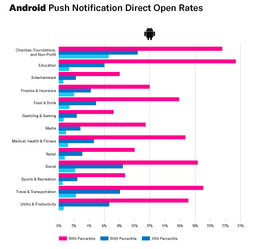Push notifications have been a critical tool for news outlets in delivering news. They have also helped increase engagement and subscriptions. Delivered through apps and websites, these notifications can change how users consume news, but they can also influence your media’s performance.
Let’s start taking a more detailed look at push notifications and in-app messages. Throughout this paper, I will reference two main sources: Airship Mobile App Push Notification Benchmarks for 2023, and Jacob Banas’s Push Notifications Research Project.
The State of Push Notifications in News Media
Push notifications have very different opt-in rates and CTRs in different platforms and industries. This makes it clear that personalization and platform-specific strategies are key to capturing and retaining reader attention. Airship’s 2023 benchmarks show that the media industry (including news media) has one of the highest frequency of push notifications. At the same time, it has below-average open rates, potentially because of news burnout in recent years. That means you must seriously consider a new approach to cut through the noise and go against this trend.
Let’s break down the latest research on the use and impact of push notifications on the web and on apps.
- Opt-in Rates: For web notifications, the median opt-in rate swings from 45% to 65% in iOS vs Android. These numbers represent a significant portion of engaged readers actively choosing to stay informed.
- CTR: The click-through rates for both mobile operating systems are the same despite their significant difference in opt-in rates.
The insights we’re diving into come from comprehensive research conducted through articles, professional conversations, and direct observation of top news outlets like BBC and CNN. This approach offers a well-rounded view of how push notifications look across the board. The strategy around these notifications is as sophisticated as their technology. From the timing and frequency of the notifications to the type of content shared, news outlets are constantly fine-tuning their approach. You should also test and fine-tune everything to find the right way to maximize engagement without overwhelming your audience. The balance is delicate: too many notifications can annoy and drive users away, while too few can make them feel out of the loop.
User Experience and Engagement
Opt-In Strategies and User Preferences
When it comes to getting users to say “yes” to notifications, it’s not about asking – it’s about how you ask. Research shows that the way news apps and websites prompt users can significantly affect opt-in rates. Options like native prompts, slide-ins, and bubbles play a role, but timing and context are key. For example, allowing users to opt into specific segments means they get more of what they want and less of what they don’t, making them more likely to engage.
Impact on User Retention
The relationship between notification frequency and user retention is a delicate dance. On one hand, data suggests that a well-balanced frequency of notifications can keep users returning for more. According to the 2022 Airship benchmarking report quoted in Banas’s Push Notifications Research Project, Android users receive an average of 114.8 notifications a month, while iOS users get about 97.7. However, the 2023 report shows that these numbers can change considerably from one industry to another.
The user experience of push notifications should not be focused only on delivering news. You can think of it as creating a personalized and respectful dialogue with your audience. By carefully considering opt-in strategies and notification frequency, news outlets can encourage engagement and loyalty in users.
Designing Content Strategies for Push Notifications
Push notifications have evolved from simple alerts to sophisticated tools for engagement. Let’s dive into how news outlets strategize content to keep readers informed and interested.
Frequency and Timing
How often and when news outlets send notifications can make a big difference. The research suggests that sending 8-10 notifications per day is the sweet spot for keeping readers updated without overwhelming them. Notably, the most effective times for sending out alerts are in the morning, between 8 am and 12 pm, and in the evening, between 8 pm and 12 am. This timing aligns with people’s daily routines, catching them when they’re most likely to check their phones.
Content Types and Personalization
The type of content shared through notifications is just as important as the frequency. Initially dominated by breaking news, their use now includes niche topics, author alerts, and even rich notifications featuring images or gifs. This shift not only caters to a wider range of interests but also emphasizes the importance of personalization. For example, some outlets allow users to opt into specific content segments. That will increase engagement over time since the notifications they receive are relevant to their interests.
The move towards more personalized and diverse content reflects a deeper understanding of reader preferences. By focusing on what readers find valuable, news outlets can increase engagement and, by extension, loyalty. Personalization, when done right, transforms notifications from mere interruptions to valuable updates.
Organizational Strategies and Best Practices
Managing push notifications is a team effort, with strategies that cross editorial lines and require tight coordination.
Managing Push Notifications
In most news organizations, the editorial team takes the lead on push notifications, often supported by audience and data teams. This setup ensures that the content not only meets editorial standards but is also aligned with audience insights and behavior data. Tools like Slack are commonly used for real-time communication among teams, helping maintain a consistent voice and strategy across all notifications.
Best Practices for News Outlets
Based on insights from leading news outlets, here are a few best practices:
- Balance Editorial Instincts with Data: Use data to inform decisions, but don’t ignore the gut feelings and expertise of your editorial team.
- Segmentation Is Key: Tailoring notifications to user interests can significantly increase engagement. Segmented notifications have shown higher click-through rates, proving personalized content is more effective.
- Test and Learn: A/B testing is crucial for understanding what works best. Experiment with different timings, frequencies, and content types to see what resonates most with your audience.
- Engage, Don’t Sell: Notifications should aim to inform and engage. The goal is to build a habit and a relationship with the user, not to push for immediate action or sale.
Best Practices for News Outlets
- Focus on Engagement and Value: Push notifications should aim to engage readers by delivering value, not just traffic. The content should be relevant and appealing to the reader, encouraging them to interact more deeply with the news brand.
- Segmentation and Personalization: Tailoring notifications to the interests of different audience segments can significantly boost engagement. Insights from the research underscore the effectiveness of segmented notifications, which see higher click-through rates compared to general blasts.
- Experimentation and Optimization: Continuously testing different approaches to push notifications, including timing, frequency, and content types, is crucial. A/B testing can reveal what works best for engaging your audience and retaining their attention.
- Data-Informed Decisions: While data should inform the content strategy, editorial judgment is also critical in decision-making. The balance between data-driven insights and editorial instincts is key to crafting notifications that resonate with readers.
- Regular Reporting and Analysis: Setting a regular cadence for reviewing performance data can help news organizations refine their push notification strategies over time. This involves not just looking at click-through rates but also how notifications contribute to broader engagement and retention goals.
Adopting these strategies can help news organizations navigate the complexities of push notifications. By focusing on user engagement, outlets can use notifications to inform and build lasting relationships with their audience.
Future Directions and Innovations
As we look ahead, the landscape of push notifications in news media is poised for further evolution. Emerging technologies and changing user behaviors are shaping new opportunities and challenges.
Emerging Trends in Push Notifications
- AI and Personalization: In the future, we will likely see greater use of AI to tailor notifications to individual user preferences and behaviors in real-time. This could mean more sophisticated segmentation and even predictive notifications, anticipating user interests before they explicitly express them.
- Interactive and Rich Media Notifications: Advancements in notification technology may enable more interactive elements, such as polls or direct actions within the notification itself. Rich media, including videos and animations, could become more common, making notifications more engaging and informative.
Challenges and Opportunities
- Privacy and User Trust: As personalization deepens, maintaining user trust and privacy becomes more critical. News outlets must navigate these concerns carefully, ensuring transparency and control for users over their data and notification preferences.
- Engagement Beyond the Click: The ultimate goal of notifications will evolve from simply driving clicks to fostering deeper engagement. This means creating a seamless experience that encourages users to explore further, engage with content more meaningfully, and build a habit around the news brand.
Measuring Push Notification Performance
Here’s a simple way to keep track of how well your push notifications are doing:
- Opt-In: You want to see how many people say “yes” to getting your notifications. If not many people are signing up, you might need to change how you ask.
- Open Rate: It’s all about how many people get your message. If they don’t see it, they can’t act on it. Sometimes, if their phone is off or they’re updating their system, they might miss it.
- CTR: This tells you how many people tapped on your notification. It’s like checking who’s interested enough to learn more. But remember, not all notifications need a click to be successful. Some just give the info right away.
- Conversions: If you want to drive conversions through these notifications, you’ll want to track how much money you’re making from them.
To measure all this, you’ll need:
- A good tool that tracks these actions. In the case of web notifications, you can use Google Tag Manager and GA4 to track events. If you’re dealing with in-app notifications, you need to use Firebase, the app analytics platform.
- To decide what success looks like for your app or website. This could mean setting up specific goals, like how many people make a purchase after getting a notification.
- Regular checks to see if you’re hitting your goals and where you might need to adjust.
And remember, it’s not just about sending messages. You want to make sure they’re the right ones, sent at the right time, and to the right people. Testing different messages and seeing what works best can really help improve your strategy.
Three Things to Remember
Push notifications are a dynamic force in the news media landscape. Aside from being tools for delivering news, they’re bridges to deeper engagement. With the right approach, notifications can improve your readers’ experience and increase subscription rates.
The key takeaways are personalization, timing, and content strategy. Tailoring alerts to user interests, delivering them at the right time, and choosing content wisely can turn passive readers into active participants. Plus, the collaboration between editorial instincts and data insights can make for resonating notifications.
The challenge for news media is to stay innovative while maintaining trust and delivering value. It’s a balancing act that requires constant adjustment and a keen eye on the future. If you’re interested in emerging trends in 2024, you can read our article on WhatsApp Newsletters – according to Reuter’s research into publisher trends, WhatsApp may be a growing channel in 2024.







